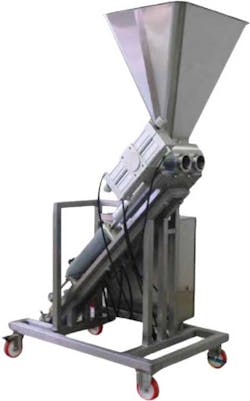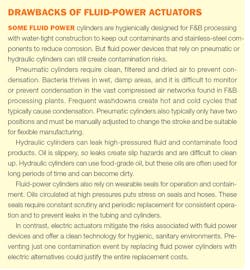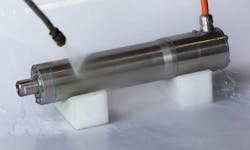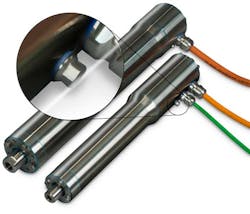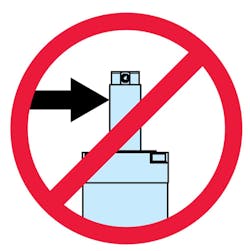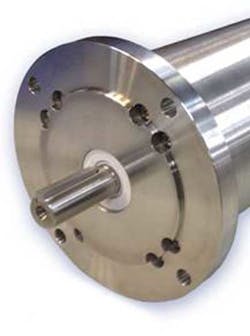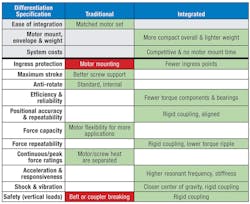3 Tips for Choosing the Right Electric Actuator for Hygienic Applications
Machines that process and package food and beverages (F&B) are continually being redesigned and refined to meet food company demands for increased automation, less production waste, greater efficiencies and lower costs. In addition to these criteria, food processing machines must meet stringent requirements to keep food clean during production and ensure it arrives to consumers safely. Standards such as the European Hygienic Engineering & Design Group (EHEDG), 3A, USDA and others define the hygienic design principles for these machines and components to prevent bacterial contamination.
Actuators are critical to food processors as they are one of the most common way products are moved efficiently. Electric actuators, in particular, are the technology of choice for an increasing number of F&B applications due to their inherent cleanliness.
Machine designers can meet manufacturer expectations and comply with food-safety standards by applying the following three best practices for specifying electric actuators for F&B processing equipment. These principles create open, clean-in-place designs that reduce the risk of bacterial contamination and improve overall machine cleanliness. Along with following these best practices, it is always a good idea to consult with EHEDG, USDA or appropriate governing agencies to ensure a design complies with current regulations.
1. Select hygienically designed actuators.
There are several criteria that go into making a design hygienic.
Proper materials. Actuators made of non-compliant materials may corrode and shed particles into the processing environment. Stainless steel is a good choice for these components as it resists corrosion, withstands tough processing conditions and complies with industry standards.
Several stainless-steel alloys are well-suited for food processing applications. For example, best practice in hygienic design for linear actuator bodies call for motor housings and fasteners to use type 316/316L due to its high level of corrosion resistance. Type 304/304L stainless is also used in some cases.
- According to the EHEDG (Hygienic Equipment Design Criteria Doc 8, April 2004): For good resistance to general atmospheric corrosion for components that will be used only with solutions having a pH between 6.5 and 8, low chloride levels (<50mg/l), and low temperatures (<25°C) the most common metal is AISI-304 stainless steel.
- If chloride levels and temperature exceed approximately double these values (100 mg/l and 50°C), the material will need greater resistance to the crevice and pitting corrosion which can result from local chloride concentrations. Adding molybdenum to AISI-304 to make AISI-316 improves its corrosion resistance.
- 316 steel can handle temperatures up to 150°C.
The steel actuator components should have a number 4 ground finish or better, and be free of pits, cracks, folds and other imperfections. This makes parts suitable for washdowns. Welded junctions, however, should be electro-polished, glass beaded or shot peened to a number 4 ground finish.
Metal alloys other than stainless steel (such as aluminum) may be suitable under certain conditions. Alloys containing lead, leachable copper or other toxic metals should be avoided.
Proper seals. Electric actuator rod seals must be made of a durable material that withstands the application’s operating conditions. Such seals are often made of Viton or ultra-high molecular weight (UHMW) polyethylene to keep contaminants and water out during washdowns and resist corrosion.
When choosing an electric actuator, companies should ensure the supplier factors in seal interference and friction for the proposed motion profile and desired life estimates. Friction between the rod seal and rod can damage the seals. Design engineers should also research the material composition of all polymers proposed for the design to ensure FDA-approved seal materials are used.
IP69K ratings are the best for actuators that will see service in the F&B environment. The most challenging area of IP69K design is the seal on the thrust rod. Seals age and wear during operation, and it takes a properly designed seal to meet and maintain an IP69K rating. Seals with tight dimension tolerances assure a correct fit on the thrust rod and the durability to withstand many extend/retract cycles.
Seals will eventually need to be replaced. Seal manufacturers generally provide guidelines for replacement frequency, but how fast a seal really wears depends on many factors, including frequency of motion, alignment, cleaning frequency and compatibility with sanitizing agents.
Made for easy cleaning. Actuators with domed or rounded bodies, rounded edges and a smooth finish prevent moisture, food particles and microorganisms from collecting and pooling. Particles and cleaning fluids easily drain off, improving the washdown process and minimizing the chances of contaminates lingering on the actuator after cleaning.
Even motor housings should be rounded to promote runoff. A properly designed electric hygienic actuator has no sharp edges or angles (≤ 90 deg.) and no flat surfaces (even transition features should have a radius of ≤ 6 mm.) that could create edges or pockets where food can lodge and stymie the cleaning process.
Operating temperatures. Ambient temperatures during food processing can range from warmer environments to refrigerator cold or even freezing environments. Several cold-warm-cold temperature cycles can occur daily, depending on the temperature of the environment, the equipment and the water (up to 176°F/80°C) used for cleaning. These variations can create condensation and put a pull vacuum in sealed equipment due to fluctuating pressures. In these environments, the combination of an IP69K rating and a breather/purge port becomes essential to keep moisture out of the actuator.
Adding a breather port. A breather port is usually placed in the back of the actuator near the cable(s). Correctly used, it keeps moisture out of the actuator by equalizing pressure inside and outside the during operation and temperature changes. This calls for an IP69k-rated face seal. Any air supplied or exchanged should be dry and clean, and the air line periodically inspected for moisture and cleaned as required.
2. Design the actuator into an open-architecture system.
Stainless steel actuators let the entire machine use an open-frame architecture. This eliminates or minimizes large steel enclosures, improves cleaning and ensures regulatory agencies will likely approve the design.
Alignment and mounting compliance. Properly aligning the actuator with respect to the application load and axis of motion minimizes side loading. But even moderate side loading exposes the extended rod and rod seals to wear and damage. This means the actuator rod must be guided or supported to minimize side loads. Loads should be aligned in parallel with the thrust rod’s line of motion.
Actuators should be oriented so that the rod extends up or horizontally, not down. This reduces the risk of contaminants getting into the actuator.
It is also important to add some level of compliance to at least one of the actuator’s two mounting points. Despite best efforts on installation, there will likely be some variation in components. So, giving the actuator some ability to move (compliance) will help avoid any binding or side loading. Using a clevis, spherical rod eye or trunnions for mounting can add compliance.
Combining servo motors with actuators. Servo motors used in hygienic applications fall into two classes:
- Those rated IP67 and painted with white epoxy. These are suitable for dry, non-contact areas rarely subjected to washdowns. Their environmental sealing, epoxy paint and nickel-plated connectors do not stand up well to common cleaning agents applied with high-pressure sprayers. The epoxy paint can flake off, cleaning fluids can enter through shaft seals and nickel-plated connectors discolor from oxidation.
- Those rated IP69K and made of stainless steel. Motors that carry the IP69K rating are ideal where hygiene and cleanliness are critical, as they are proven to be durable and resist water, chemicals, high pressure and high temperatures associated with demanding cleaning and safety measures.
Flanges available on hygienic motors include the XXX C-Type flange (Rockwell VPH shown), which is easier to seal and clean, reduces areas for harborage and should include an FDA compliant O-ring. Before choosing a C-type flange motor, make sure the motor supplier provides an O-ring (some motor suppliers force the user to source the O-ring separately).
Another option is the XXX D-Type flange (Elwood W-Series shown), which is difficult to seal and clean. It frequently does not provide O-rings or gaskets and just suggests using RTV to seal the motor-to-actuator interface.
Cable management. Over time, liquid contaminants such as oil and cleaning solutions may accumulate on the cables and cable glands. To minimize the introduction of contaminants to the glands, mounting the actuator with the cable gland down is suggested. Mounting with the gland to the side requires a bend or drip loop. Actuators should not be mounted such that the cable gland points up. If mounting the actuator with the cable gland facing up is unavoidable, the cable should be routed with a drip loop prior to entering the cable gland. Units mounted with the cable glands on the bottom surface of the actuator require no looping.
3. Compare actuators.
Design engineers must also choose between an integrated motor/actuator design and a more traditional design with the motor separate from the actuator and attached before installation on the final machine. With just an actuator, an in-line motor mounting configuration or a reverse parallel (RP) design can be used. In the reverse parallel design, the motor mounts parallel to the actuator and uses a belt and pulley or geared mechanism to transfer power. This design makes for a much smaller footprint but has have some significant additional costs.
An actuator and motor combined in single piece eliminates the typical seals between the motor and actuator. This reduces the number of points for possible moisture to get in or bacteria to thrive. It also eliminates the risk of seals being ripped or off-center when installed.
The following table provides a quick comparison of both types of actuator/motor designs:
Andrew Zaske is vice president of sales and marketing and Sean Halverson is a mechanical engineer at Tolomatic, Inc.
This article appeared on Machine Design.
About the Author
Sean Halverson
Mechanical Engineer, Tolomatic
Andrew Zaske
Vice President of Sales and Marketing, Tolomatic

Leaders relevant to this article:


